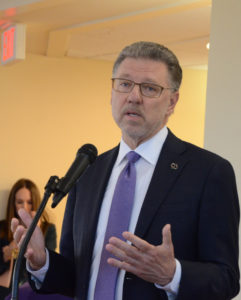
By Steve Brawner
The first sign that Walt Klusmeier’s had Alzheimer’s was when he asked his wife, Lisa, how to send an email on his phone. He was 49 years old.
Then he needed help with expense reports on his laptop. When that happened, Lisa assumed was the result of stress caused by his responsibilities as a father of three children and as a pharmaceutical sales rep.
“I just thought he had this huge territory, had a lot of responsibility,” she said. “Our kids were growing. We were a busy family.”
But it was more than stress. He would withdraw at home. While he learned to compensate for his failing cognition, his work was subpar, which his employer interpreted as a lack of commitment. Eventually he lost his job, which meant the family lost not only his income but his insurance, and he didn’t qualify for government benefits because of his age. The money ran out. After he was diagnosed with younger-onset Alzheimer’s, he became eligible for Social Security Disability payments and two years later for Medicare. He lived at home until his last month of life and died at age 58.
Lisa, who lives in Fayetteville, Ark., shared her story Monday along with others at a meeting in the state’s capital, Little Rock. Also present were representatives from four of the state’s six congressional offices and the Alzheimer’s Association’s national president and CEO, Harry Johns.
The disease afflicts more than 5 million Americans and about 55,000 Arkansans – most older than Walt, of course. It’s the sixth leading cause of death in Arkansas, which has the nation’s seventh highest Alzheimer’s death rate, according to the association.
If you’ve ever had a loved one with Alzheimer’s or other dementia, then you know what it does to the victim. You also know that the family suffers as well. The Alzheimer’s Association estimates that 15 million unpaid caregivers are serving their loved ones across the country and 176,000 are doing it here in Arkansas. According to Johns, whose mother died of the disease, the extreme hardship endured by caregivers sometimes leads them to die first.
It’s impossible to calculate the disease’s human cost. The financial cost is a little easier. The Alzheimer’s Association estimated that society would spend about $259 billion in 2017 caring for Alzheimer’s and other dementias, a number that is expected to rise to $1.1 trillion by the middle of the century. That’s not including the costs of all those caregivers missing work and developing their own health problems. To put it in perspective, the entire federal budget this year was $4 trillion, $666 billion of that borrowed.
Thankfully, there’s good news. Johns said the research is promising. While we’re nowhere near a cure, the scientific community believes it is on the path toward stopping the disease’s progression, maybe even before the symptoms appear.
Johns said Congress has done a good job of recognizing the disease’s human and economic costs. In 2014, it passed the Alzheimer’s Accountability Act requiring scientists at the National Institutes of Health to give an annual target for how many research dollars they effectively can use. That amount – $1.8 billion this year – is expected to be fully funded. Johns hopes next year’s request of $2 billion will be funded as well.
“If we could stop or slow progression by five years, even five years, we’d cut the problem at least in half,” he said.
This year, for every $1 spent on Alzheimer’s research, $125 were spent on patient care. Unlike other diseases like cancer, the $259 billion spent on Alzheimer’s in 2017 didn’t provide any cures or lead to significant patient improvements, and we don’t know how to prevent the disease. We’re just keeping patients alive, sometimes for a decade, while their loved ones suffer each day.
So can we afford to spend $2 billion on Alzheimer’s research? Actually, we can’t afford not to.
© 2017 by Steve Brawner Communications, Inc.